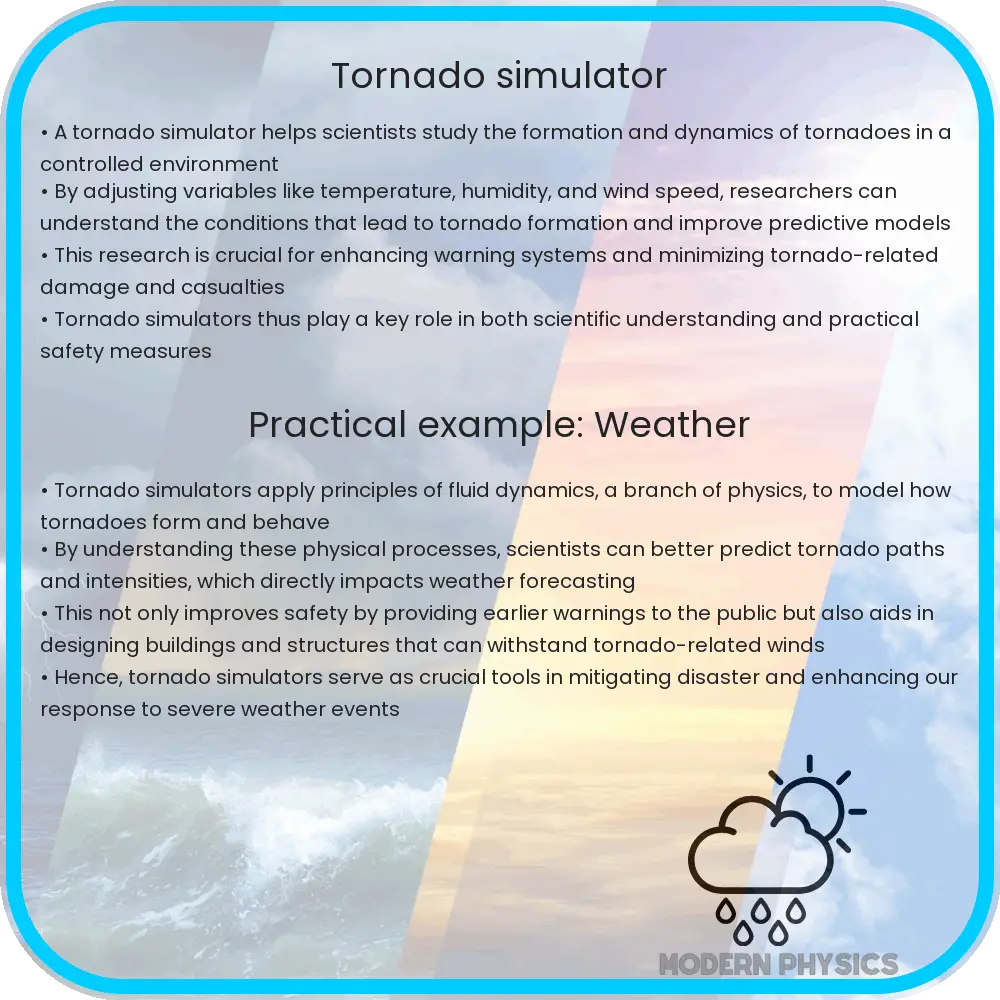Tornado simulators are educational tools that replicate tornado conditions for research and safety studies.

Exploring Tornado Simulators: Immersive, Accurate, and Educational
Tornado simulators are powerful educational tools that replicate the behavior and conditions of tornadoes within a controlled environment. They offer researchers, students, and weather enthusiasts an up-close look at the dynamics of tornadoes, allowing for a deeper understanding and enhanced safety measures. By combining physics, engineering, and technology, these simulators create a realistic yet safe way to study one of nature’s most awe-inspiring phenomena.
Design and Mechanics of Tornado Simulators
At the heart of a tornado simulator is a combination of powerful fans and advanced software. The fans are used to replicate the wind speeds and rotational forces observed in real tornadoes. These can range from just a few miles per hour to over 200 miles per hour, mimicking various categories of tornado intensity. The design typically involves a vertically oriented wind tunnel where these wind forces can be controlled and monitored.
Advanced computational fluid dynamics (CFD) software plays a crucial role in simulating the air flow characteristics, providing visual and data-centric insights into how tornadoes form, evolve, and dissipate. This software utilizes a range of equations, primarily derived from the Navier-Stokes equations which govern the motion of fluid substances. Simplified, these equations can be expressed as:
ρ(dv/dt) = -∇p + μ∇2v + f
Where:
- ρ represents the density of the fluid,
- v is the velocity field,
- p stands for the pressure field,
- μ is the dynamic viscosity, and
- f denotes external forces (like gravity).
This formulation helps create simulations that closely mirror the turbulent flow of winds in a tornado, providing valuable insights into the pressure and velocity fields within a simulated tornado scenario.
Applications of Tornado Simulators for Education and Research
Tornado simulators are not just limited to research; they play a significant role in educational contexts as well. Schools and universities use these simulators to provide students with a practical understanding of tornado dynamics. Through interactive sessions, students can observe how changes in variables such as temperature, wind speed, and humidity can affect the development and path of a tornado. This hands-on approach helps demystify complex meteorological concepts and encourages a deeper interest in science and physics.
For researchers, tornado simulators are indispensable in studying tornado behavior without the inherent risks of field chasing. They can experiment with different atmospheric conditions to see how they might influence tornado formation and strength. This is crucial for developing more accurate predictive models that can be used to enhance early warning systems, ultimately saving lives and mitigating damage from these unpredictable natural disasters.
Moreover, by using these simulators, engineers can test the resilience of building materials and structures against tornado-induced winds. This is vital for designing buildings, especially in tornado-prone areas, to withstand high-velocity winds and protect residents during a real tornado event.
Enhancing Public Awareness and Safety through Simulation Technology
One of the critical aspects of disaster management is public education and awareness. Tornado simulators serve an essential role in this domain by creating immersive experiences that help the general public understand the severity and potential impact of tornadoes. Workshops utilizing these simulators can demonstrate the importance of taking appropriate safety precautions and following evacuation protocols during tornado warnings.
Moreover, tornado simulators allow for interactive demonstrations where participants can visualize the effects of not adhering to safety measures. These realistic simulations can have a significant impact on public behavior, potentially leading to fewer casualties and less property damage during actual tornado events.
Future Prospects and Technological Innovations
The future of tornado simulation technology holds promising advancements. With the integration of augmented reality (AR) and virtual reality (VR), simulators could become even more immersive and realistic. These technologies would allow individuals to experience the full force of a tornado virtually, offering an unparalleled understanding of these massive storms without any physical risk.
Researchers are also exploring the possibility of enhancing simulation accuracy by incorporating real-time weather data into the simulation algorithms. This could lead to more detailed and accurate predictions of tornado behavior, improving both educational outcomes and the effectiveness of early warning systems.
- Integration of machine learning to predict changes in tornado behavior based on past data
- Improvements in CFD software for more finely tuned simulations
- Collaborative international efforts to develop global tornado response strategies
These innovations will not only advance academic understanding and preparedness but also pave the way for public safety enhancements worldwide.
Conclusion
Tornado simulators embody the remarkable convergence of physics, engineering, and technology. They are pivotal in interpreting and predicting the behaviors of tornadoes, facilitating a proactive approach to learning and disaster preparedness. By offering a controlled, safe environment to study these volatile phenomena, simulators provide invaluable insights to both scientists and the public alike.
As technology progresses, we can anticipate even more sophisticated and effective uses of tornado simulation technologies. The ongoing development of these tools represents a critical frontier in meteorological research and public safety, helping to shield communities from the potentially devastating impacts of tornadoes. Engaging with these technologies not only furthers scientific and engineering knowledge but also profoundly serves society by enhancing safety and resilience against natural disasters.
